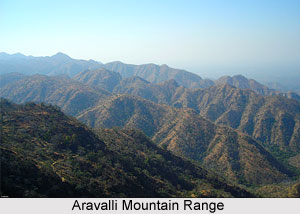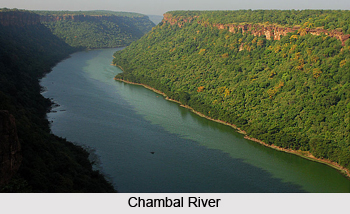 Baran District is located in the state of Rajasthan. Situated at a height of 262 metres above sea level, the district is located in the south eastern corner of Rajasthan. The maximum length of the district from North to South is 103 Kms. and maximum width from west to east is 104 Kms. The land of the district slopes gently from south to north and the drainage is through Chambal River and its tributaries. The land slopes gently northward from the high tableland of Malwa in Madhya Pradesh. It is well watered, drained by rivers flowing in north and north-eastern directions. The main drainage of the land is through the Chambal River and its tributaries. There are hills in the south, north and eastern portion of the district and it is generally fertile. The highest point, Mammooni, lies among the hills in the east in the Shahabad tehsil. It is 546 meters above mean sea level. These hills form a part of the Aravalli mountain ranges. They have steep and gentle slopes and are mostly covered with woods.
Baran District is located in the state of Rajasthan. Situated at a height of 262 metres above sea level, the district is located in the south eastern corner of Rajasthan. The maximum length of the district from North to South is 103 Kms. and maximum width from west to east is 104 Kms. The land of the district slopes gently from south to north and the drainage is through Chambal River and its tributaries. The land slopes gently northward from the high tableland of Malwa in Madhya Pradesh. It is well watered, drained by rivers flowing in north and north-eastern directions. The main drainage of the land is through the Chambal River and its tributaries. There are hills in the south, north and eastern portion of the district and it is generally fertile. The highest point, Mammooni, lies among the hills in the east in the Shahabad tehsil. It is 546 meters above mean sea level. These hills form a part of the Aravalli mountain ranges. They have steep and gentle slopes and are mostly covered with woods.
The climate of the district is mostly dry. The winter season extends from mid-November to February, and the summer season runs from March to mid-June. The monsoon season is from mid June to September, and it is followed by the post monsoon season, lasting from October to mid November. The average rainfall in the Baran district is about 854.5 mm. The coldest month is that of January with an average daily temperature of 24 degree Celsius and an average daily minimum temperature of 10.6 degree Celsius.
The main river of the Baran district is the Parvati River, an auxiliary of the Chambal River. This enters Baran from the Kariyahat kasba of Chhabra Tehsil from Madhya Pradesh. It separates the Kishanganj Tehsil from Chhabra, Atru, Baran and Mangrol Tehsils.
 One of the most important rivers of the Hadoti region is the Kali Sindh River. It flows for around 40 Kms along the western border of the Mangrol tehsil, after merging with the Parvan River. The uncertainty of floods is quite high with this river. One of the largest rivers in the state of Rajasthan, the Palaytha, has been constructed over this river. The Parvan River is the auxiliary of the Kali Sindh River. It enters the Baran district from the southern part of the Harnavdashahaji kasba. From there, it maintains its flow along the south-western border of the Chhipabarod, Atru, Baran and Mangrol tehsils and merges into the Kali Sindh River. The Andheri River enters Baran from nearby Chhipabarod. It runs for about 15 Kms bordering Madhya Pradesh and Rajasthan and finally merges into the Parvati River near Atru. The Ban Ganga River is the rainy river which passes through Bamla and Sehrod in the southern part of Baran. After passing east of Baran city and west of Bohat and Mangrol Kasba, it merges with the Parvati River. The irrigation facilities available in the district are mainly in the form of canals, tubewells and wells. The rivers Parvati, Kalisindh and Parwan provide an important source of canal irrigation.
One of the most important rivers of the Hadoti region is the Kali Sindh River. It flows for around 40 Kms along the western border of the Mangrol tehsil, after merging with the Parvan River. The uncertainty of floods is quite high with this river. One of the largest rivers in the state of Rajasthan, the Palaytha, has been constructed over this river. The Parvan River is the auxiliary of the Kali Sindh River. It enters the Baran district from the southern part of the Harnavdashahaji kasba. From there, it maintains its flow along the south-western border of the Chhipabarod, Atru, Baran and Mangrol tehsils and merges into the Kali Sindh River. The Andheri River enters Baran from nearby Chhipabarod. It runs for about 15 Kms bordering Madhya Pradesh and Rajasthan and finally merges into the Parvati River near Atru. The Ban Ganga River is the rainy river which passes through Bamla and Sehrod in the southern part of Baran. After passing east of Baran city and west of Bohat and Mangrol Kasba, it merges with the Parvati River. The irrigation facilities available in the district are mainly in the form of canals, tubewells and wells. The rivers Parvati, Kalisindh and Parwan provide an important source of canal irrigation.
Soil found in the district is mainly black Kachari soil, found primarily in the Baran and Mangrol tehsils. This soil is highly fertile. Stony soil is found in the southern and eastern part of the district. Owing to the absence of metamorphic rocks, no metallic ore of importance except Bauxite occurs in the district. However a variety of non-metallic minerals are exposed, important among them being sandstone and limestone. Besides, small deposits of red clay, glass-sand, dolomite and kankar are also found. The main mineral of the district is building stone.
The forest area of the district is around 2.15 lacs. The forests are mainly concentrated in the south-western and central portion of the Mukundra hills, which have a rich forest belt. The main forests found of the district are Sagavan, Kher, Salan, Gargsari. Local wild animals are panther, sloth, bear, chital, wild bear, chinkara, sambar, langoor, jackal etc. Birds found in the district are bulbul, sparrow, peacock, saras, teetar etc. Among the poisonous snakes, cobra, passel and viper are common. Water snakes are also seen near the tanks. Crocodiles are sometimes seen in the big tanks and in certain pools in Chambal and Kali Sindh rivers.






